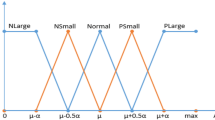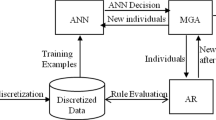Abstract
In this paper, a hybrid model consisting of the fuzzy ARTMAP (FAM) neural network and the classification and regression tree (CART) is formulated. FAM is useful for tackling the stability–plasticity dilemma pertaining to data-based learning systems, while CART is useful for depicting its learned knowledge explicitly in a tree structure. By combining the benefits of both models, FAM–CART is capable of learning data samples stably and, at the same time, explaining its predictions with a set of decision rules. In other words, FAM–CART possesses two important properties of an intelligent system, i.e., learning in a stable manner (by overcoming the stability–plasticity dilemma) and extracting useful explanatory rules (by overcoming the opaqueness issue). To evaluate the usefulness of FAM–CART, six benchmark medical data sets from the UCI repository of machine learning and a real-world medical data classification problem are used for evaluation. For performance comparison, a number of performance metrics which include accuracy, specificity, sensitivity, and the area under the receiver operation characteristic curve are computed. The results are quantified with statistical indicators and compared with those reported in the literature. The outcomes positively indicate that FAM–CART is effective for undertaking data classification tasks. In addition to producing good results, it provides justifications of the predictions in the form of a decision tree so that domain users can easily understand the predictions, therefore making it a useful decision support tool.











Similar content being viewed by others
References
Stylios CD, Georgopoulos VC, Malandraki GA, Chouliara S (2008) Fuzzy cognitive map architectures for medical decision support systems. Appl Soft Comput 8(3):1243–1251
Uzoka FME, Obot O, Barker K, Osuji J (2011) An experimental comparison of fuzzy logic and analytic hierarchy process for medical decision support systems. Comput Methods Programs Biomed 103(1):10–27
Azar AT, El-Metwally SM (2013) Decision tree classifiers for automated medical diagnosis. Neural Comput Appl 23(7–8):2387–2403
Yan H, Jiang Y, Zheng J, Peng C, Li Q (2006) A multilayer perceptron-based medical decision support system for heart disease diagnosis. Expert Syst Appl 30(2):272–281
Lisboa PJ, Taktak AF (2006) The use of artificial neural networks in decision support in cancer: a systematic review. Neural Netw 19(4):408–415
Lim CP, Leong JH, Kuan MM (2005) A hybrid neural network system for pattern classification tasks with missing features. IEEE Trans Pattern Anal Mach Intell 27(4):648–653
Vigdor B, Lerner B (2006) Accurate and fast off and online fuzzy ARTMAP-based image classification with application to genetic abnormality diagnosis. IEEE Trans Neural Netw 17(5):1288–1300
Loo CK, Rao MVC (2005) Accurate and reliable diagnosis and classification using probabilistic ensemble simplified fuzzy ARTMAP. IEEE Trans Knowl Data Eng 17(11):1589–1593
Tan SC, Rao MVC, Lim CP (2009) An online pruning strategy for supervised ARTMAP-based neural networks. Neural Comput Appl 18(4):387–395
Kolman E, Margaliot M (2005) Are artificial neural networks white boxes? IEEE Trans Neural Netw 16(4):844–852
Basak J, Krishnapuram R (2005) Interpretable hierarchical clustering by constructing an unsupervised decision tree. IEEE Trans Knowl Data Eng 17(1):121–132
Hullermeier E, Vanderlooy S (2009) Why fuzzy decision trees are good rankers. IEEE Trans Fuzzy Syst 17(6):1233–1244
Young WA II, Weckman GR, Hari V, Whiting HS II, Snow AP (2012) Using artificial neural networks to enhance CART. Neural Comput Appl 21(7):1477–1489
Steinberg D, Colla P (1995) CART: tree-structured non-parametric data analysis. Salford Systems, San Diego
Economou GP, Goumas PD, Spiropoulos K (1996) A novel medical decision support system. Comput Control Eng J 7(4):177–183
Jin M, Li R, Xu Z, Zhao X (2014) Reliable fault diagnosis method using ensemble fuzzy ARTMAP based on improved Bayesian belief method. Neurocomputing 133:309–316
Decanini JGMS, Tonelli-Neto MS, Minussi CR (2012) Robust fault diagnosis in power distribution systems based on fuzzy ARTMAP neural network-aided evidence theory. Gener Transm Distrib IET 6(11):1112–1120
Haque AU, Mandal P, Meng J, Srivastava AK, Tseng TL, Senjyu T (2013) A novel hybrid approach based on wavelet transform and fuzzy ARTMAP network for predicting wind farm power production. IEEE Trans Ind Appl 49(5):2253–2261
Liang Z, Xu B, Chi Z, Feng D (2012) Intelligent characterization and evaluation of yarn surface appearance using saliency map analysis, wavelet transform and fuzzy ARTMAP neural network. Expert Syst Appl 39(4):4201–4212
Gharavian D, Sheikhan M, Nazerieh A, Garoucy S (2012) Speech emotion recognition using FCBF feature selection method and GA-optimized fuzzy ARTMAP neural network. Neural Comput Appl 21(8):2115–2126
Loo CK, Liew WS, Seera M, Lim E (2014) Probabilistic ensemble Fuzzy ARTMAP optimization using hierarchical parallel genetic algorithms. Neural Comput Appl. doi:10.1007/s00521-014-1632-y
Navarro Silvera SA, Mayne ST, Gammon MD, Vaughan TL, Chow WH, Dubin JA, Risch HA (2014) Diet and lifestyle factors and risk of subtypes of esophageal and gastric cancers: classification tree analysis. Ann Epidemiol 24(1):50–57
Mohanty AK, Senapati MR, Beberta S, Lenka SK (2013) Texture-based features for classification of mammograms using decision tree. Neural Comput Appl 23(3–4):1011–1017
Mohanty AK, Senapati MR, Lenka SK (2013) A novel image mining technique for classification of mammograms using hybrid feature selection. Neural Comput Appl 22(6):1151–1161
Xing JJ, Liu YF, Li YQ, Gong H, Zhou YP (2014) QSAR classification model for diverse series of antimicrobial agents using classification tree configured by modified particle swarm optimization. Chemometr Intell Lab Syst 137:82–90
Yu H, Song Y, Liu R, Pan H, Xiang L, Qian F (2014) Identifying changes in dissolved organic matter content and characteristics by fluorescence spectroscopy coupled with self-organizing map and classification and regression tree analysis during wastewater treatment. Chemosphere 113:79–86
Seera M, Lim CP, Loo CK (2014) Motor fault detection and diagnosis using a hybrid FMM–CART model with online learning. J Intell Manuf. doi:10.1007/s10845-014-0950-3
Romano R, Davino C, Næs T (2014) Classification trees in consumer studies for combining both product attributes and consumer preferences with additional consumer characteristics. Food Qual Prefer 33:27–36
Carpenter GA, Tan AH (1995) Rule extraction: from neural architecture to symbolic representation. Connect Sci 7(1):3–27
Carpenter GA, Grossberg S, Markuzon N, Reynolds JH, Rosen DB (1992) Fuzzy artmap: a neural network architecture for incremental supervised learning of analog multidimensional maps. IEEE Trans Neural Netw 3(5):98–713
Zadeh LA (1965) Fuzzy sets. Inf Control 8(3):338–353
Lim CP, Harrison RF (1997) An incremental adaptive network for on-line supervised learning and probability estimation. Neural Netw 10(5):925–939
Pasiouras F, Tanna S, Zopounidis C (2005) Application of quantitative techniques for the prediction of bank acquisition targets, vol 5. World Scientific, Singapore
Chen Y, Wang S, Shen CH, Choy FK (2012) Matrix decomposition based feature extraction for murmur classification. Med Eng Phys 34(6):756–761
Waheed T, Bonnell RB, Prasher SO, Paulet E (2006) Measuring performance in precision agriculture: CART—a decision tree approach. Agric Water Manag 84(1):173–185
Han J, Kamber M, Pei J (2012) Data mining: concepts and techniques, 3rd edn. Morgan Kaufmann, MA
Yohannes Y, Webb P (1999) Classification and regression trees. International Food Policy Research Institute, USA
Bache K, Lichman M (2013) UCI machine learning repository [http://archive.ics.uci.edu/ml]. Irvine, CA: University of California, School of Information and Computer Science
Delen D, Walker G, Kadam A (2005) Predicting breast cancer survivability: a comparison of three data mining methods. Artif Intell Med 34(2):113–127
Loo CK (2005) Accurate and reliable diagnosis and classification using probabilistic ensemble simplified fuzzy ARTMAP. IEEE Trans Knowl Data Eng 17(11):1589–1593
Hanley JA, McNeil BJ (1982) The meaning and use of the area under a receiver operating characteristic (ROC) curve. Radiology 143(1):29–36
Efron B (1979) Bootstrap methods: another look at the Jackknife. Ann Stat 7(1):1–26
Zoubir AM, Boashash B (1998) The bootstrap and its application in signal processing. Sig Process Mag IEEE 15(1):56–76
Efron B, Tibshirani R (1993) An introduction to the bootstrap. Chapman and Hall, New York
Örkcü HH, Bal H (2011) Comparing performances of backpropagation and genetic algorithms in the data classification. Expert Syst Appl 38(4):3703–3709
Stoean R, Stoean C (2013) Modeling medical decision making by support vector machines, explaining by rules of evolutionary algorithms with feature selection. Expert Syst Appl 40(7):2677–2686
Luukka P (2011) Feature selection using fuzzy entropy measures with similarity classifier. Expert Syst Appl 38(4):4600–4607
Çalişir D, Dogantekin E (2011) A new intelligent hepatitis diagnosis system: PCA–LSSVM. Expert Syst Appl 38(8):10705–10708
Chen HL, Liu DY, Yang B, Liu J, Wang G (2011) A new hybrid method based on local fisher discriminant analysis and support vector machines for hepatitis disease diagnosis. Expert Syst Appl 38(9):11796–11803
Dayanik A (2012) Learning feature-projection based classifiers. Expert Syst Appl 39(4):4532–4544
Özşen S, Güneş S (2009) Attribute weighting via genetic algorithms for attribute weighted artificial immune system (AWAIS) and its application to heart disease and liver disorders problems. Expert Syst Appl 36(1):386–392
Nahar J, Imam T, Tickle KS, Chen YPP (2013) Computational intelligence for heart disease diagnosis: a medical knowledge driven approach. Expert Syst Appl 40(1):96–104
Çomak E, Polat K, Güneş S, Arslan A (2007) A new medical decision making system: least square support vector machine (LSSVM) with fuzzy weighting pre-processing. Expert Syst Appl 32(2):409–414
Acknowledgments
This research is partially supported by University of Malaya Research Grant RP003D-13ICT.
Author information
Authors and Affiliations
Corresponding author
Rights and permissions
About this article
Cite this article
Seera, M., Lim, C.P., Tan, S.C. et al. A hybrid FAM–CART model and its application to medical data classification. Neural Comput & Applic 26, 1799–1811 (2015). https://doi.org/10.1007/s00521-015-1852-9
Received:
Accepted:
Published:
Issue Date:
DOI: https://doi.org/10.1007/s00521-015-1852-9




